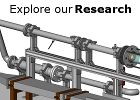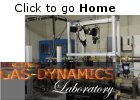Coal Gasification
At present, 85% of the world's energy is derived from fossil fuels, presenting challenges with respect to energy supply security and environmental protection. In order to transition to a long-term sustainable energy future, it is essential that fossil fuels are used in such a way as to minimize their environmental impact until the time when renewable sources are capable of meeting our energy needs. Carbon dioxide capture and storage (CCS) that employs gasification and pre-combustion capture of CO2 recognized as one of a suite of technology options that can be used to reduce greenhouse gas (GHG) emissions from continued fossil fuel usage.
Gasification is defined as the process of reacting a carbon-rich feedstock (coal, petroleum coke, biomass, waste, etc.) with steam and oxygen to form a synthesis gas containing H2 and CO. It can be viewed globally as extremely rich combustion and usually utilizes solid or liquid feedstocks. Developing an understanding of the physical, chemical and dynamic processes involved in gasification through multiscale simulation will allow us to optimize gasifier design and plant layout, increasing reliability, availability and maintainability of gasification-based energy systems, while decreasing costs.
Solid Conversion
Throughout their conversion, solid fuel particles undergo many complex physical and chemical processes, and modeling these phenomena with sufficient accuracy is a key component to simulating the reacting flow inside entrained flow gasifiers. Broadly speaking, it is possible to divide the solid particle conversion into two phases: devolatilization and char consumption. Additionally, while the volatile gases and tar escape the particle, the char structure is formed, and it may look nothing like that of the original feedstock particle. Thus there are three essential processes that will be modeled: devolatilization, char structure formation, and char consumption. Current work is focused on char consumption modeling, which is done within the framework of a reaction-diffusion type equation for each char particle that is tracked. Sub-models for diffusion within the porous particle, heterogeneous and homogeneous reaction kinetics, surface area evolution and several other key processes are included. This approach allows for spatial and temporal variations within the particles and therefore yields improved accuracy and the ability to predict certain processes that aren't possible using an integral (effectiveness factor) approach.
Novel Gasification Concepts
Multi-scale simulation tools are being co-developed for the purpose of evaluating state-of-the-art gasifier designs and generating a framework for studying novel gasification concepts. This task is currently focused on the assessment of coal-liquid carbon dioxide slurry (CCO2S) as an alternative to coal-water slurry (CWS) for the feeding system of pressurized gasifiers. Liquid carbon dioxide is readily available in plants with carbon capture and its thermophysical properties are significantly more attractive than those of water, promising better feedstock flexibility, system cost, and performance. The chemistry and kinetics of gasification in a CO2-rich atmosphere, the interaction of liquid CO2 and coal, and the techno-economics of coal-CO2 slurry are among the multiple aspects of this concept being studied. Modeling tools on the system and reduced-order level, as well as computational fluid dynamics are being used for this purpose.
Computational Fluid Dynamics
Detailed modeling of a gasifier, including microscale modeling of solid conversion and Computational Fluid Dynamics (CFD) modeling of both phases, is needed to define internal operating conditions, failure modes, to optimize designs, etc. FLUENT RANS modeling of the coal gasification process in a pilot-scale entrained flow gasifier has been performed. The predicted results are in reasonable agreement with available experimental data, although further improvements of the heterogeneous reaction model and other submodels are needed. LES reduces the uncertainty associated with using turbulence models in RANS modeling, especially for the highly transient gasifier environment. FLUENT LES modeling of the same gasifier is undergoing. An in-house research code is also being developed for the flow dynamics in entrained flow gasifiers. The code is currently being validated using experimental data for a swirling flow in a cylindrical sudden expansion, which has some of the key features of the flow in entrained flow gasifiers.
Radiation Turbulence Chemistry Interaction
The design of gasifiers and their operation has largely been an experience based enterprise. The gasification models developed over the years have not been robust enough to apply to a wide range of operating conditions, gasifier geometries and feedstocks. The primary reason behind this shortcoming is the failure to incorporate detailed physics and chemistry of all the coupled non-linear phonemena occuring during solid fuel gasification. Gasification inherently involves a complicated, non-linear coupling of various physical/chemical phenomena including devolatilization, swirl-induced turbulent mixing, homogeneous/heterogeneous combustion, radiative/convective heat transport, slag formation etc. Before we aim to accurately predict overall metrics of gasifier performance like fuel conversion and syngas composition, we need to build a satisfactory level of confidence in the sub-models of the various physical processes in the gasifier. In this work, we build, refine and validate the various submodels involved in the multiscale CFD modeling of entrained flow gasification.
Dynamic Reduced Order Modeling
In order for entrained flow gasification to become a mainstream and cost-effective energy conversion technology, a number of technical design issues must be addressed. These include: lack of dynamic feedstock flexibility, injector failure, refractory failure, slag blockages and corrosion, poor space efficiency, downstream fouling and poisoning, and poor plant integration. Detailed modeling is one method whereby improved gasifier designs can be analyzed. These models would ideally employ Computational Fluid Dynamics (CFD) and extremely detailed submodels to predict temperature, composition and char conversion distributions. Such detail makes integration of these models with process flowsheet models of the overall plant difficult and impractical. For this reason, we propose to develop Dynamic Reduced Order Models (DROMs) for gasifiers, which capture the most important physical processes of gasification, but without the computational intensity of more detailed simulation. The primary functions of the DROMs will be to investigate and optimize the dynamic interaction of the gasifier with the rest of the plant.




